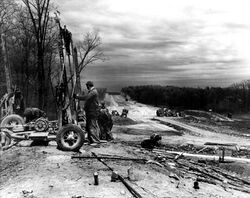Great Aerlan Highway
The Great Aerlan Highway (Commonspeak: Gröt Ayrlen Autostras) is the name given to a transportation megaproject whos aim is to link all major cities in Aerla with each other via highway. The first phase of construction began in 1715 AN, and the completion of the entire system is estimated to be somewhere in the range of the late 1720 ANs.
History
Background
The lack of continuous land routes for transportation has plagued the Central Keltian valleys for centuries. Upon Aerla's inception in 1709 AN. the longest continuous "road" was a dirt trackway from Zareda to Noursala. The government soon diverted large portions of their budget to modernizing infrastructure (most of this going towards the Harriston-Agalore Rail Corridor. completed in early 1718 AN). The lack of established highway systems was accredited as a reason the response to the Insurgency in Ancora was so delayed, as troops had to be deployed via winding dirt roads and small narrow-gauge railroads.
The National Assembly approved a bill in 1715 AN to begin construction on a "Great Aerlan Highway" that would link all major population centers together. The bill was approved with a majority vote, and the plan was signed by Henry Cassian the following day. The first phase of construction began with a ceremonial christening of a excavator in Noursala by Transportation Minister Maurice Bridgeman.
Construction
Groups of workers began clearing right of ways away from each of the terminuses. Heavy logging equipment was provided via government funds to help clear vast swathes of forest that lie between each cities. Tunnels through major hills were cleared by either mining crews or explosives, if appropriate.

